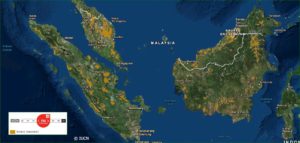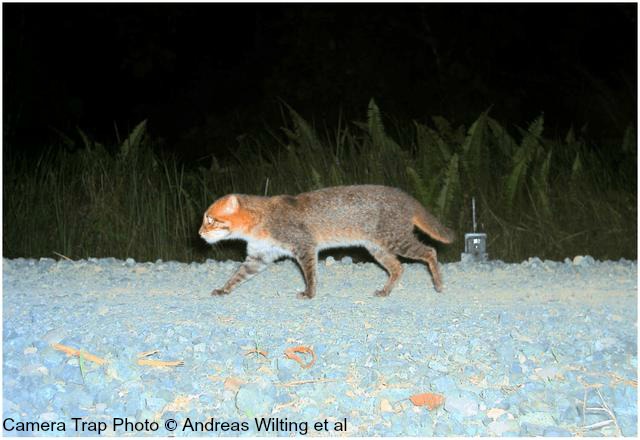- HB Length: 45-52 cm (18-20″)
- Tail Length: 12-17 cm (4.7-7″)
- Height: 33-50 cm (13-20″)
- Weight: 1.5-2.5 kg (3.3-5.5 lbs)
- Pop. Trend: Decreasing
The Flat-headed Cat Prionailurus planiceps is one of the most unusual members of the cat family, with their long, narrow head and flattened forehead.
About the size of a domestic cat, they have an elongated body, short legs with small, rounded paws, and a short tail. The coat is thick, soft and long, reddish brown on top of the head and dark brown on the body, with a fine speckling of grey and buff on the tips. The muzzle, chin and cheeks are white, with short, white stripes at the inner edge and along the lower margins of eyes, and two dark streaks on each cheek. A yellow line runs up from each eye to near the ear. Underparts are also white, and generally more or less spotted and splashed with brown. Large, brown eyes are set closely together, and short, rounded ears are set well down the sides of the head. The legs are short and can have some indistinct horizontal markings. The short tail is thickly furred, reddish brown above and yellowish underneath.
Flat-headed Cats share one characteristic with the Cheetah Acinonyx jubatus, and Fishing Cat Prionailurus viverrinus, in that their claws are not fully retractile, and can be seen at all times. Their toes are more completely webbed than those of the Fishing Cat, and they have long, narrow footpads.
Filling the role of a semi-aquatic carnivore, the long, narrow jaws and pointed, backward facing teeth are adaptations to catching and holding slippery prey such as fish and frogs. These cats may well be more deserving of the name ‘fishing cat’ than the species that already has that name.
Distribution

The Flat-headed Cat is found on Sumatra, Borneo and on the Malayan Peninsula but is likely extinct in Thailand. Very little is known about this species and the understanding of its current distribution is based on a comparably low number of occurrence records. It is generally seldom seen and is believed to be rare. Its distribution is thought to be very patchy and to be highly localized around water bodies. No density estimates exist so far.
In 2013, the second-ever photographic evidence of Flat-headed Cats in Peninsular Malaysia was captured by camera traps in the Pasoh Forest Reserve. Two cats were seen moving together during daylight hours in lowland forest far from water, and 1.5 km from a palm oil plantation.
In 1995, two Flat-headed Cats were observed by zoologists along the Merang River on Sumatra. These sightings were the first confirmed record for Berbak National Park, and park officers had never observed or heard of the species. In 1996, the first ever photo of a Flat-headed Cat in the wild was taken by camera trap on the island of Sumatra.
Habitat
The Flat-headed Cat inhabits tropical lowland rainforests, swampy areas, marshes, lakes, streams, peat-swamp forest and riverine forest.Generally, it is closely associated with wetlands and almost all photo records are from extreme lowland areas, mainly below 100 m. The Flat-headed Cat has also been observed in secondary forest and the few records from oil palm plantations were always from close proximity to forested areas.
Ecology
Very little is known about the Flat-headed Cat’s ecology and behaviour. It is believed to be a solitary, nocturnal and crepuscular animal. With the increase of scientific studies of various animals on Borneo, the number of sightings of these cats has increased. Their prey species are thought to be aquatic such as fish, frogs and crabs.
Almost all sightings have been along rivers, streams, small ponds or water-filled ditches. They have also been observed swimming across rivers. Similar to other cats it sprays urine marks, but does so unlike any other cat: it walks forward in a crouching position leaving a trail on the ground.
One cat was observed in an area that had been selectively logged in 2004. Coming across the cat at night, its reflected eyeshine was picked up by the flashlights of the researchers. When it was first spotted, the cat froze in position, then unhurriedly turned and walked back into thick undergrowth.
In 2005, a group of primate researchers on Borneo accidentally trapped a Flat-headed cat. It was released in a forested area about 10 metres away from a riverbank. When the cage door was opened, the cat walked to the riverbank, slid into the water and dived. It reappeared and swam about 25 metres to the other side of the river before walking along the bank and out of sight. It is interesting to note the cat headed to the water for safety, instead of the shelter of the trees.
In 2013 camera trap records in Malaysia were obtained by the Tropical Ecology Assessment & Monitoring Network (TEAM), who monitor long term trends in tropical biodiversity. The photos were obtained after the camera had been moved by monkeys, which reduced its height from 40 cm to about 10 cm above the forest floor. Due to the cat’s small size, they likely move through undergrowth and on small trails, while most camera trap projects are set on more open, larger animal trails. Current camera traps are also likely set too high for the detection of these cats.
Reproduction
The scant information available on the Flat-headed Cat’s reproductive habits includes a young kitten that was found in the wild in the month of January. It had much the same colouration as the adults except that it was somewhat greyer. It developed adult colouration at one year of age. Gestation is approximately 56 days, with one to four kittens born. Captive animals have lived to 14 years.
See our blog post Flat-headed Cat and kitten with video taken in Borneo Oct 2018.
Threats
- rapid loss of habitat due to human activities, especially oil palm plantations
- toxic water pollution from agricultural run-off and logging
- persecution
- depletion of fish stocks due to over fishiing by humans
- snaring and poisoning
Conservation
The Flat-headed Cat is one of the most endangered cat species in the world. Over 70% of their historical habitat has been converted to croplands, plantations and other land cover types unsuitable to these cats. Remaining habitats are highly fragmented.
There are some indications that Flat-headed Cats occur in secondary forest but there is very little evidence that they are found in oil palm plantations. Southeast Asia has the world’s highest deforestation rate (e.g. over 1.3 million hectares of lowland forest are deforested annually on the island of Borneo) with Malaysia and Indonesia being among the largest palm oil producers.
Flat-headed Cats inhabit mainly lower-altitude gentle terrain, which are facing high levels of clearance. In addition, waterways are often the areas first destroyed as settlement expands. They have also been reported to take domestic poultry which means persecution by farmers.
Researchers with The Bornean Clouded Leopard Program studying the five wild cats of Borneo have recorded Flat-headed Cats on camera trap surveys, identifying areas where they occur on the island.
More research is needed to evaluate if Flat-headed Cats use oil palm plantations or if they are only forced to pass through the plantations due to the fragmentation of their habitats. There is also generally an urgent need for further research on the status, ecology, distribution, threats and conservation needs across its range.
The World Conservation Union has given the Flat-headed Cat the highest conservation priority of any of the small South East Asian wild cats. The possibility exists that they will disappear before we have a chance to ensure their survival.
Compare these unusual cats to the Fishing Cat who shares much of their range.
Range map IUCN Red List (2008)
Updated 2019


Pat Bumstead
Yes we would love to see your videos, and put them on our website with your permission. Flat-headed cat researchers are always interested in any videos of these little known cats as well. Please email us at smallwildcats@gmail.com
Barry Robinson
Hi,we recently seen a flat headed cat in Sukau, Sabah off the Kinabatangan river on 10th Aptil 2019.
This is our second sighting, the first was 3 years ago down the same tributary river.
We have video of both if it is of any help.
Pat Bumstead
YES we are very interested! Any sighting of these cats is big news in cat conservation world. Can you please email what you have to smallwildcats [at] gmail.com and we’ll pass it along to the Borneo researchers.
AmyEA
We were lucky enough to sight one of these cats yesterday in Tanjung Puting National Park. We caught the two cats on film, if anyone is interested.